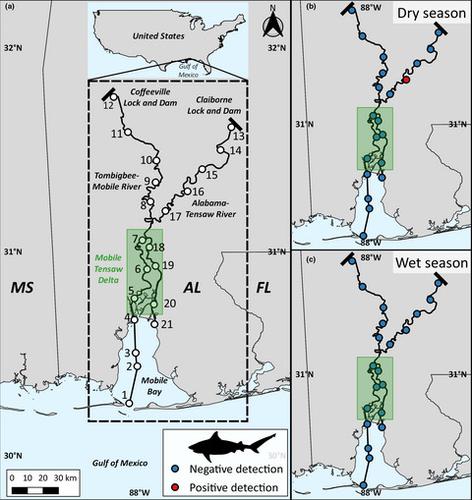当前位置:
X-MOL 学术
›
Ecol. Evol.
›
论文详情
Our official English website, www.x-mol.net, welcomes your feedback! (Note: you will need to create a separate account there.)
Swimming against the flow—Environmental DNA can detect bull sharks (Carcharhinus leucas) across a dynamic deltaic interface
Ecology and Evolution ( IF 2.6 ) Pub Date : 2020-12-21 , DOI: 10.1002/ece3.7101 James Marcus Drymon 1, 2 , Katherine E. Schweiss 3 , Emily A. Seubert 1 , Ryan N. Lehman 3 , Toby S. Daly‐Engel 4 , Mariah Pfleger 5 , Nicole M. Phillips 3
Ecology and Evolution ( IF 2.6 ) Pub Date : 2020-12-21 , DOI: 10.1002/ece3.7101 James Marcus Drymon 1, 2 , Katherine E. Schweiss 3 , Emily A. Seubert 1 , Ryan N. Lehman 3 , Toby S. Daly‐Engel 4 , Mariah Pfleger 5 , Nicole M. Phillips 3
Affiliation

|
Human activities in coastal areas are accelerating ecosystem changes at an unprecedented pace, resulting in habitat loss, hydrological modifications, and predatory species declines. Understanding how these changes potentially cascade across marine and freshwater ecosystems requires knowing how mobile euryhaline species link these seemingly disparate systems. As upper trophic level predators, bull sharks (Carcharhinus leucas) play a crucial role in marine and freshwater ecosystem health. Telemetry studies in Mobile Bay, Alabama, suggest that bull sharks extensively use the northern portions of the bay, an estuarine–freshwater interface known as the Mobile‐Tensaw Delta. To assess whether bull sharks use freshwater habitats in this region, environmental DNA surveys were conducted during the dry summer and wet winter seasons in 2018. In each season, 5 × 1 L water samples were collected at each of 21 sites: five sites in Mobile Bay, six sites in the Mobile‐Tensaw Delta, and ten sites throughout the Mobile‐Tombigbee and Tensaw‐Alabama Rivers. Water samples were vacuum‐filtered, DNA extractions were performed on the particulate, and DNA extracts were analyzed with Droplet Digital™ Polymerase Chain Reaction using species‐specific primers and an internal probe to amplify a 237‐base pair fragment of the mitochondrial NADH dehydrogenase subunit 2 gene in bull sharks. One water sample collected during the summer in the Alabama River met the criteria for a positive detection, thereby confirming the presence of bull shark DNA. While preliminary, this finding suggests that bull sharks use less‐urbanized, riverine habitats up to 120 km upriver during Alabama's dry summer season.
中文翻译:

逆流而行-环境DNA可以检测跨动态三角洲界面的公鲨(Carcharhinus leucas)
沿海地区的人类活动正以前所未有的速度加快生态系统的变化,导致栖息地丧失,水文改良和掠夺性物种减少。要了解这些变化如何在海洋和淡水生态系统中潜在地级联,就需要知道流动的鱼腥藻物种如何将这些看似分散的系统联系起来。作为高营养水平的天敌,鲨鱼(Carcharhinus leucas))在海洋和淡水生态系统健康中发挥着至关重要的作用。在阿拉巴马州莫比尔湾的遥测研究表明,大鲨鱼广泛使用了该湾的北部,这是一个河口与淡水的交界处,被称为莫比尔-天索三角洲。为了评估公牛鲨是否在该地区使用淡水栖息地,在2018年的夏季干燥和冬季潮湿的季节进行了环境DNA调查。在每个季节,在21个站点中的每个站点收集了5×1 L水样本:Mobile中的五个站点湾,莫比尔-天索三角洲的六个地点,以及莫比尔-汤比吉比河和Tensaw-阿拉巴马河的十个地点。将水样品真空过滤,对颗粒进行DNA提取,DNA提取物通过Droplet Digital™聚合酶链反应使用物种特异性引物和内部探针进行分析,以扩增公鲨中线粒体NADH脱氢酶亚基2基因的237个碱基对片段。夏季在阿拉巴马河采集的一份水样符合阳性检测的标准,从而确认了公牛鲨DNA的存在。虽然初步,但这一发现表明,在阿拉巴马州的干旱夏季,公鲨使用城市化程度较低的河流栖息地,上游可达120公里。
更新日期:2021-01-08
中文翻译:

逆流而行-环境DNA可以检测跨动态三角洲界面的公鲨(Carcharhinus leucas)
沿海地区的人类活动正以前所未有的速度加快生态系统的变化,导致栖息地丧失,水文改良和掠夺性物种减少。要了解这些变化如何在海洋和淡水生态系统中潜在地级联,就需要知道流动的鱼腥藻物种如何将这些看似分散的系统联系起来。作为高营养水平的天敌,鲨鱼(Carcharhinus leucas))在海洋和淡水生态系统健康中发挥着至关重要的作用。在阿拉巴马州莫比尔湾的遥测研究表明,大鲨鱼广泛使用了该湾的北部,这是一个河口与淡水的交界处,被称为莫比尔-天索三角洲。为了评估公牛鲨是否在该地区使用淡水栖息地,在2018年的夏季干燥和冬季潮湿的季节进行了环境DNA调查。在每个季节,在21个站点中的每个站点收集了5×1 L水样本:Mobile中的五个站点湾,莫比尔-天索三角洲的六个地点,以及莫比尔-汤比吉比河和Tensaw-阿拉巴马河的十个地点。将水样品真空过滤,对颗粒进行DNA提取,DNA提取物通过Droplet Digital™聚合酶链反应使用物种特异性引物和内部探针进行分析,以扩增公鲨中线粒体NADH脱氢酶亚基2基因的237个碱基对片段。夏季在阿拉巴马河采集的一份水样符合阳性检测的标准,从而确认了公牛鲨DNA的存在。虽然初步,但这一发现表明,在阿拉巴马州的干旱夏季,公鲨使用城市化程度较低的河流栖息地,上游可达120公里。


























 京公网安备 11010802027423号
京公网安备 11010802027423号